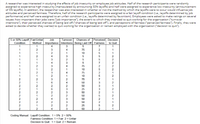
MATLAB: An Introduction with Applications
6th Edition
ISBN: 9781119256830
Author: Amos Gilat
Publisher: John Wiley & Sons Inc
expand_more
expand_more
format_list_bulleted
Concept explainers
Question
8-

Transcribed Image Text:Assume that we know the population mean for turnover intentions is u = 2.00. Is the mean for our current sample of employees significantly
different from the population mean? Use an a = .01.
Which of the following accurately represents the null and alternative hypothesis?
O Họi H = 2
Hạ:H 2
O Ho: H = 2
H: H =2
Ο H0 μ- 2.5
H2:H 2.5
O Ho: H = 2
H1:H =2.5

Transcribed Image Text:A researcher was interested in studying the effects of job insecurity on employee job attitudes. Half of the research participants were randomly
assigned to experience high insecurity (manipulated by announcing 50% layoffs) and half were assigned to experience low insecurity (announcement
of 5% layoffs). In addition, the researcher was also interested in whether or not the method by which the layoffs were to occur would influence job
attitudes and perceived fairness. Therefore, half of the research participants were assigned to a fair layoff condition (i.e., layoffs determined by job
performance) and half were assigned to an unfair condition (i.e., layoffs determined by favoritism). Employees were asked to make ratings on several
issues: how important their jobs were ("job importance"), the extent to which they intended to quit working for the organization ("turnover
intentions"), their perceived chances of being laid off ("chances of being laid off"), and perceptions of fairness ("perceived fairness"). Finally, they were
asked to decide whether they wanted to quit working for the organization or remain employed with the organization ("decision to quit").'
5 or 50% Layoff Fair/Unfair
Job
Turnover
Chances of Perceived Decision
Condition
Method Importance Intentions Being Laid Off Fairness
to Quit
4
3
7
1
2
3
75
2
1
1
2
10
1
2
4
5
1
1
3
5
2
1
1
4
3
5
7
1
2
3
4
75
2
2
1
2
1
10
2
1
3
4
75
2
1
1
2
10
3
2
75
7
1
1
6.
2
4
50
2
2
2
2
50
1
2
1
6
3
25
3
2
2
2
2
50
1
2
1
2
2
50
2
2
2
4
3
50
2
1
2
2
3
50
1
2
2
25
5
2
2
4
3
50
2
1
Coding Manual: Layoff Condition: 1= 5% 2 = 50%
Fairness Condition: 1 = Fair 2 = Unfair
Decision to Quit: 1= Quit 2= Remain
Expert Solution
This question has been solved!
Explore an expertly crafted, step-by-step solution for a thorough understanding of key concepts.
Step by stepSolved in 2 steps with 1 images

Knowledge Booster
Learn more about
Need a deep-dive on the concept behind this application? Look no further. Learn more about this topic, statistics and related others by exploring similar questions and additional content below.Similar questions
Recommended textbooks for you
 MATLAB: An Introduction with ApplicationsStatisticsISBN:9781119256830Author:Amos GilatPublisher:John Wiley & Sons Inc
MATLAB: An Introduction with ApplicationsStatisticsISBN:9781119256830Author:Amos GilatPublisher:John Wiley & Sons Inc Probability and Statistics for Engineering and th...StatisticsISBN:9781305251809Author:Jay L. DevorePublisher:Cengage Learning
Probability and Statistics for Engineering and th...StatisticsISBN:9781305251809Author:Jay L. DevorePublisher:Cengage Learning Statistics for The Behavioral Sciences (MindTap C...StatisticsISBN:9781305504912Author:Frederick J Gravetter, Larry B. WallnauPublisher:Cengage Learning
Statistics for The Behavioral Sciences (MindTap C...StatisticsISBN:9781305504912Author:Frederick J Gravetter, Larry B. WallnauPublisher:Cengage Learning Elementary Statistics: Picturing the World (7th E...StatisticsISBN:9780134683416Author:Ron Larson, Betsy FarberPublisher:PEARSON
Elementary Statistics: Picturing the World (7th E...StatisticsISBN:9780134683416Author:Ron Larson, Betsy FarberPublisher:PEARSON The Basic Practice of StatisticsStatisticsISBN:9781319042578Author:David S. Moore, William I. Notz, Michael A. FlignerPublisher:W. H. Freeman
The Basic Practice of StatisticsStatisticsISBN:9781319042578Author:David S. Moore, William I. Notz, Michael A. FlignerPublisher:W. H. Freeman Introduction to the Practice of StatisticsStatisticsISBN:9781319013387Author:David S. Moore, George P. McCabe, Bruce A. CraigPublisher:W. H. Freeman
Introduction to the Practice of StatisticsStatisticsISBN:9781319013387Author:David S. Moore, George P. McCabe, Bruce A. CraigPublisher:W. H. Freeman

MATLAB: An Introduction with Applications
Statistics
ISBN:9781119256830
Author:Amos Gilat
Publisher:John Wiley & Sons Inc

Probability and Statistics for Engineering and th...
Statistics
ISBN:9781305251809
Author:Jay L. Devore
Publisher:Cengage Learning

Statistics for The Behavioral Sciences (MindTap C...
Statistics
ISBN:9781305504912
Author:Frederick J Gravetter, Larry B. Wallnau
Publisher:Cengage Learning

Elementary Statistics: Picturing the World (7th E...
Statistics
ISBN:9780134683416
Author:Ron Larson, Betsy Farber
Publisher:PEARSON

The Basic Practice of Statistics
Statistics
ISBN:9781319042578
Author:David S. Moore, William I. Notz, Michael A. Fligner
Publisher:W. H. Freeman

Introduction to the Practice of Statistics
Statistics
ISBN:9781319013387
Author:David S. Moore, George P. McCabe, Bruce A. Craig
Publisher:W. H. Freeman